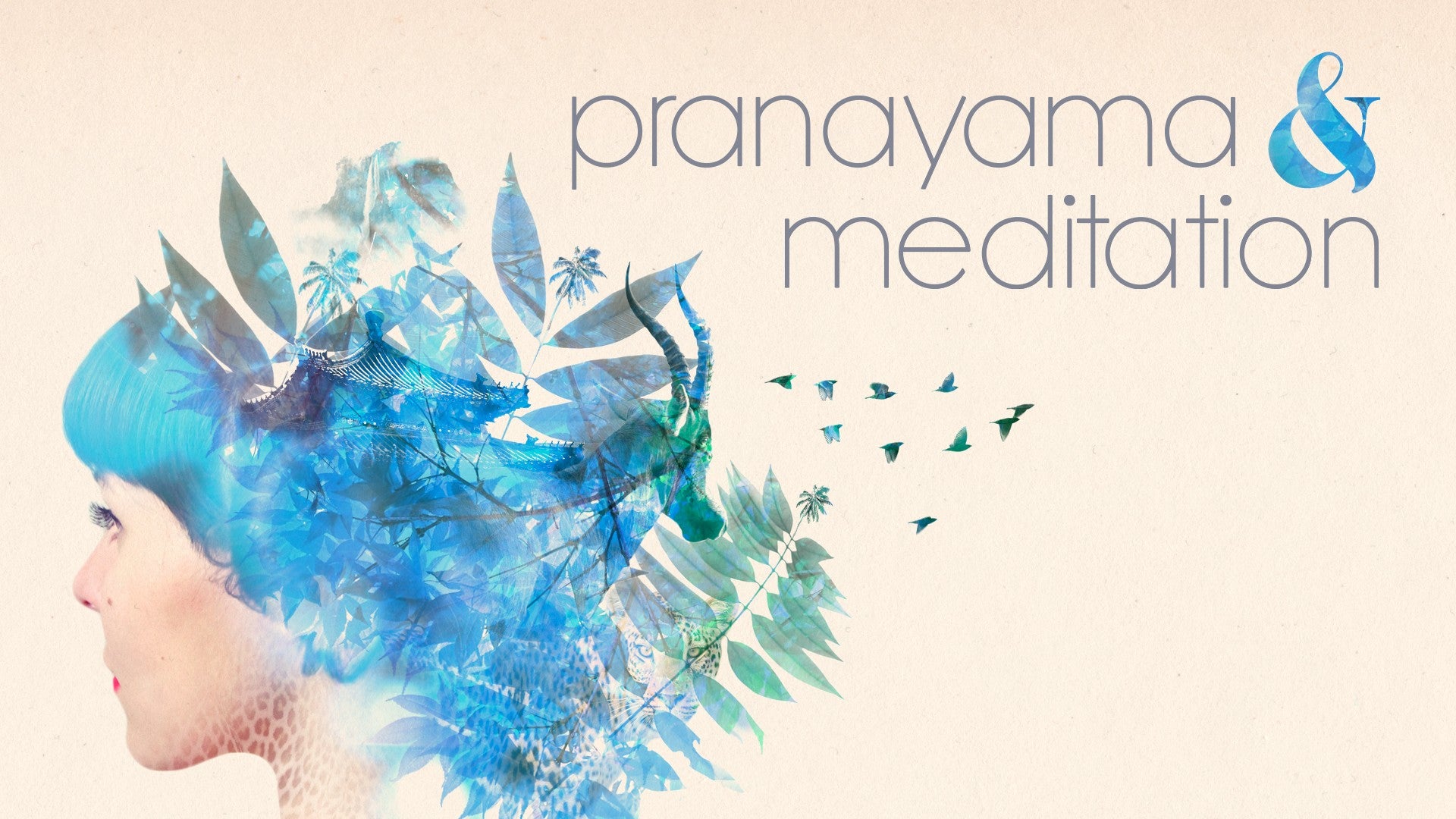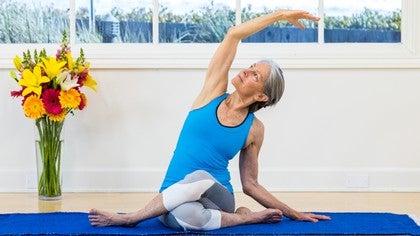Description
Transcript
Read Full Transcript
Hi, everybody. We're here today with Citrine and Rosemary. They're going to help me show you a floor squat that will work on the positioning of the skull over the spine and transition into a short sit. Citrine is going to demonstrate with a blanket under the knees, which helps if your knees don't like to fold entirely, completely together. Rosemary is going to practice with a blanket under her heels because for a number of people, it's very difficult to get the heels down and the pose is so much more nourishing and easy to release into. With both of these props, one or the other, if you happen to need them, so I'd like you to see that. Okay, so you guys can come up onto your squatting position. Feet can be turned out a little bit, coming down with your hips and folding over so that you can round down. Yes, so your back is rounded and as you're breathing, can you feel how the ribs in the back body expand and how the lower back expands? So that's first. And really sink down through your hips and your belly and the crease between your thighs and your pelvis. We want that to release. It's not a doing, it's a releasing. Good. Now, can you bring your hands up off of the floor and onto the back of your skull? So you're still folded forward in this pose and they're putting your hands behind your skull to help release the skull away from the neck. And you pull to however strongly feels good to you to release the neck. And I think of this as the backdoor to the third eye. There's a spacious opening back there that cannot be felt if there's a closure between the skull and the neck. So they've got a pretty nice stretch there. How about you? Okay. And then when you start to lift up into the pose, now we're going to bring the pose more into a straight back. You're going to put your elbows more into the knee area, over the knee area, rather than the forearms. And that brings you up. And just watch that you're, you know, watch from your inside, from your sensation, that your chin isn't popping up again, or you could lift it up to feel the difference when you move backward from your chin towards the ears where the jawline is and up towards the base of your skull. And that really helps the posture of the back to become nice and straight. And take a deep breath in there, releasing it from your belly. And just notice how the breath presses on your body. And this allows for diaphragm massage, organ massage. And next we're going to just continue with that little bit of massaging and stretching open the ribs in the diaphragm by a twist. So the, I'm going to have you to put your right hand on your right knee and your left elbow to the inside of your left knee. And let that help you turn away from the left knee. Yeah. Good. And again, just, you're kind of squeezing the diaphragm and the torso as you do this. And so breathe into that squeeze, because that breathing into the squeeze against the resistance actually helps things to release. And as you release your breath, fully release your breath. Keep that nice, long open back of the neck and skull relationship. One more inhale and then exhale and release yourself around to the center for a moment. Take a deep breath and then switch sides. So now your right elbow is going to stay on the inside of your right knee and your left hand to your left knee and you're turning around towards the left. And you're attending to your breath, the sensations inside your body, the sense of a little bit of resistance that you're breathing into. One more inhale, releasing the groin as you also release around back to the center. And then going to let you further release your groin by coming out of Namaste with the hands and bringing your hands down to the floor and rolling over so that you're coming into like a Virasana shape with your legs. So you're bringing your knees down, thighs parallel to each other and your toes stretching back if they will. So oftentimes the ankles are a little tight after that and you can kind of take your time. You can press down on the back of the calf to make it easier to sit.
And then not really holding this for very long because you're going to put your hands behind you, fingers facing towards your knees. Yeah, you can move the blankets if necessary. And you're going to lift your hips out off of the floor and upwards so that you become a straight line from your knees up to your pelvis. And it's less about lifting the chest and more about opening this space between the thigh and the hip. So the hip points are strongly lifting up towards the chest. And in fact, I would encourage you to undo the lift of the chest for a few moments and just feel into the work of the pelvis that connection. Yeah, so good. And then bring your hips down again, either on or between your feet. And then you're going to roll over onto your forearms and you can leave your right knee where it is, but take your left leg back and you're going to stretch the toes and the calf by pushing backward with your forearms. Yeah. And notice whether or not you're folding at that back door to the third eye again. Yeah, it's something to keep reminding yourself of because it becomes, your nervous system becomes quite sensitized to that and begins to notify you when you're cutting yourself off by a high chin. Okay. Then you can switch sides, bring the left knee forward and take your right leg back. You're pushing over the ball of the foot, pushing backward into the heel so that the heel moves as far away from your hips as you can as feels comfortable. You want to be able to tolerate it. It's a nice calf stretch. We think it's nice. It's funny how often we put that adjective in front of the word stretch. All right. And then you can bring your knee forward and let's transition into a seated position. So you can take a blanket if you would like one and sit cross-legged, or perhaps you might at home like more height. You could even sit in a chair. The thing that's important about the sitting posture more than anything else is, well, two things. Your sense of being received through the hips and thighs and comfortable and a spine that feels like it's growing upward.
Okay. So you might want to use your hands or just use your inner mind, your inner hands to lift the base of the skull again and then bring your hands back down. And then what I'd like you to try is to bring your chin forward and up a little and feel what happens to your posture after about 10 or 15 seconds. Yeah. Okay. And then connecting your chin to the back of the jaw line to your skull again right there where it joins the neck, moving slightly backward. Notice if you can feel a little nice little opening up here underneath and including the collarbones spreading. I usually feel my shoulder blades drop down and the spine is much longer. So just feeling into, does this allow you to breathe all the way down into the floor of your pelvis, into your belly. So with this upright but comfortable posture, you're going to begin to work with several dimensions of breathing. We have a vertical dimension that we can breathe. So begin breathing in, relaxing your belly so that the breath comes down to the navel below the navel on the in breath. And then on the out breath, gently pressing your lower belly back so that you can feel the breath comes up and out and in and down. So once it goes down, it's like filling a glass of water. The breath is going to continue coming up into the torso. See if you can feel that on your in breath and then transition into out breath and let the breath escape out however it wants to. So this is the longitudinal direction of three-dimensional, the longitudinal dimension. Long from bottom to in top doesn't have to be all the way up to the shoulders. It can be a little below the collarbones. So keep a comfortable filling. Breathing in and down to fill up and releasing the breath out again and maintaining that sense of long. So not collapsing with the exhale. That's very nice. And then just relax your breathing again and begin to imagine that your breath, you're coming into another dimension and the dimension that you're coming into now is front to back. So breathe into your back ribs, your lower and middle back ribs, as well as your chest at the same time. Now that's not always so easy to do. So you first place it into your imagination. Breathing in, front to back, breathing out, allow that to naturally sort of recoil back to the center. You may feel it in your belly as well. If you feel a lot of breath in your belly and not much in your chest, breathe in towards the front belly, but also imagine you've got a belly back there behind. And let that area soften to receive the breath at the same time that your belly does. That's the in-breath and then the out-breath. Same thing, just allowing for a natural recoil. So from front to back, narrows again, expanding front to back on the in-breath, releasing so you narrow again naturally on the out-breath. Good. Maybe one more of those.
Just really feel into it. Let your breath come back to a normal kind of feeling. Going back to unregulated breathing helps you to see and feel what you've been doing. Maybe you recognize certain aggressiveness or certain something else that you didn't recognize while you were breathing. And then from, we've got the third dimension. And the third dimension is, I'm going to call, circumferential. So now when you breathe in, you could start at the belly and imagine that the belly goes all the way around your hips and pelvis. And that as you're breathing out, there's this circumferential expansion. And then circumferentially, everything releases back into the middle. Feel the smoothness of this and the ease of it. It's not meant to be hard work. It's just imaginary space-creating inside of you. So, circumferentially opening, either at the belly or belly and ribs. And I can see how, if you're watching and listening, you can see a lot of this in Satrine and Rosemary. As I glance at them, I can see the movements they're creating. All right, so one more circumferential opening. Again, without strain, it's just imaginary space-creating something to awaken you and sensitize you to what happens when you breathe.
And then let it go. And of course, we're going to want to put all of these together. So gently at first, just imagine the three dimensions. A long dimension, vertically long, a dimension of broad from front to back, and then the circumferential, which adds the lateral dimension. So the front to back and lateral dimensions come together. And don't try to take big giant breaths. Just imagine this happening perhaps first in the belly and up towards the chest. Three-dimensional breathing. Smooth, gentle, tongue soft. Let there be a sense of eyes and brain descending softly, which actually goes with the chin back. Breathing in long, broad, and deep. Breathing out, feeling the gradual coming back to whatever normal space feels like. And as you finish the breath that you're doing right now, let your breath find its own pace. Let your eyes find a position which is soft.
And we'll just spend the last couple of minutes tuning into what's already happening, what's been happening with this process, but now without the doing of it, just being. There's so much to notice. Just notice what you notice. Okay. And then bring your palms together in front of your heart. Feel the connection of hands to heart, connection to your own being, the nourishment you've just given yourself. Namaste. Thank you very much.
Pranayama & Meditation: Patricia Sullivan
Comments
You need to be a subscriber to post a comment.
Please Log In or Create an Account to start your free trial.









